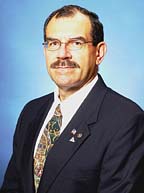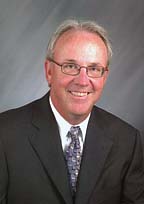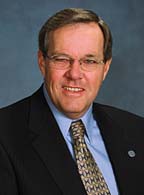
The group included Skip Snyder, chairman of the Air Conditioning Contractors of America (ACCA) and owner of the Snyder Company, Upper Darby, Pa.; Mark Watson, president of the Sheet Metal and Air Conditioning Contractors' National Association (SMACNA) and project manager for Climate Engineers, Cedar Rapids, Iowa; Don Frendberg, executive vice president and chief operating officer of the Heating, Airconditioning & Refrigeration Distributors International (HARDI), Columbus, Ohio; and Dave Pannier, 2004 chairman of the board of the Air-Conditioning and Refrigeration Institute (ARI) and president, residential systems for Trane and American Standard, Tyler, Texas.

Issues Facing Contractors
"Our biggest obstacle is our lack of business skills," Snyder said. "In order to address the manpower issue, we must first understand what good business is. Many contractors just don't understand their profit potential. A well-funded business will pay top dollar for service techs."Snyder believes that the best way to learn business skills is to network with other contractors. He is a member of an ACCA MIX® Group, a collection of noncompetitive contractors with similar business structures.
"I encourage all ACCA members to join a MIX Group and all contractors to join ACCA," Snyder said. "We have to help ourselves first and educate our employees. Education unleashes talent.
"NATE [North American Technician Excellence] is going to be a branded, recognizable commodity as a standard of excellence. Our service techs are worthy of better incomes than other professions, i.e., auto mechanics."
Snyder pointed to Rheem's decision to pay ACCA membership dues for its dealers as an important development. "This was significant because it raises the bar of professionalism in our trade," he stated.
Snyder sees the value of combining industry trade shows. He noted the Ohio ACCA chapter and the Ohio Plumbing-Heating-Cooling Contractors (PHCC) recently held a joint meeting near Cleveland. "Cross-pollination of ACCA and PHCC is great," he said. "It shows that both groups want the same thing. By offering continuing education units (CEU), we are providing a good hook to bring people to these meetings. We need to incorporate more CEUs into these meetings, too."

"SMACNA and its labor partners, the Sheet Metal Workers' International Association (SMWIA), will be focusing their efforts on an image campaign that communicates our members' HVAC expertise to our customers," he said.
"Expertise covers quality of workmanship, productivity and efficiency, training, and having a vast pool of talented labor quickly available. We believe that owners would much rather see jobs done right the first time than deal with jobs that require fixing later on."
He noted that both SMACNA and SMWIA will hold meetings during a weeklong "Partnership Conference" in May, and the organizations will ask for feedback from owners and general contractors during the meetings.
"During the programs, both labor and management will receive step-by-step professional business plans to get in on the ground floor of opportunities in architectural, HVAC, industrial and residential markets," Watson indicated. "Sitting side-by-side in these and many more educational sessions can only serve to strengthen our partnership and further our labor management partnership process."
Watson sees other problems facing contractors, such as the cost of doing business.
"SMACNA contractors may be looking at the price of steel as a short-term problem, like so many price fluctuations in past years, but this time is almost certain to be different," he said.
"Demand from China is the primary factor driving the current price run-up in steel and it is unlikely that China's appetite for steel, or other metals, will abate anytime soon. Metal prices are likely to remain high throughout 2004 and for the foreseeable future. Supplies, already affected, may be very tight as production capabilities try to catch up with demand.
"While higher HVAC equipment efficiency requirements do not go into effect until early 2006, SMACNA contractors should start preparing now for the changes the higher efficiency mandate will bring. Compounding the move to higher efficiencies is the mandated phaseout of R-22. Manufacturers have already begun showcasing new non-CFC equipment.
"Higher equipment prices are certain to accompany the new high-efficiency, non-CFC equipment. This may cause some groups to defer air conditioning replacements, which could depress overall unitary sales and increase competition for a shrinking market."

The Distributor's Perspective
Frendberg touched on some topics that loom large for the industry in 2004, noting that many issues facing his trade are no different from the ones it faced 20 years ago."As they say, the more things change, the more they stay the same," he said. "For distributors, the critical issues in 2004 sound very much like 1994 or 1984: rising costs (energy and steel in particular), shortages (steel, again), refrigerant issues (new equipment with R-410A), new limited rules on HFC venting and sales, new competition, and shrinking margins, to name a few.
"However, distributors in our commodity line are really doing much better than others (industrial distributors had negative sales growth last year). Members expect to experience a 3 to 8 percent sales growth in 2004 according to our opinion survey. HARDI's computer-generated forecast for the third and fourth quarters expects our sales index to stand, respectively, at 160 and 169, versus last year's actual of 141 and 156."
Frendberg said that consolidation of the distribution trade is in "hiatus," adding, "Presently 36 percent of HARDI members are single location companies - down slightly from 40 percent three years ago. Smaller independent wholesalers continue to find ways to differentiate themselves from large distributors and captive (manufacturer-owned) sales outlets by serving selected contractors in very unique ways.
"Our controls distributors are perhaps the largest and best example of such a business strategy. These firms essentiality sell no equipment, and have a staff that is highly technically trained. Their stock inventory is deep with specialized controls, and through their master distributor connections, they have an almost unlimited inventory of controls immediately available.
"Affiliation with buying groups and marketing co-ops also help small firms compete and provide more value-added services to their customers."
Frendberg also listed some HARDI initiatives designed to address some of the industry's growing problems.
"HARDI multibranch firms continue to develop useful branch performance measures and effective branch manager training. In this regard, several of HARDI's committees have worked together to bring truly effective branch manager schools to different parts of the country."
He noted that HARDI's Future Studies Committee wants to "increase the gathering and dissemination of marketing information that HARDI distributors can provide the industry's manufacturers and our contractor customers."
The association has also taken steps designed to help distributors find and train qualified employees and boost the industry's image.
"HARDI offers scholarships and grants to deserving young people and HARDI members nominate outstanding academic educators to participate as guests in our annual conference. Members want to help the teachers become better informed about job opportunities in wholesaling.
"Is it possible that more community service by industry organizations and individual firms could be an image builder? HARDI is involved with Habitat for Humanity, and many contractors provide free furnace checks for elderly and low-income families. These are also great to build employee pride.
"The public image of our industry is already changing because our industry itself is changing. Years ago, sheet metal craftsmen were called tin-knockers. Heat transfer technology will continue to change the knowledge base required of technicians. How about Ben & Jerry's new thermo-acoustic ice cream chiller? That same technology may cool our homes, say our manufacturing suppliers.
"We must also make an HVACR career financially attractive. Good pay really gets a young person's attention. To be able to pay well, everyone in the channel must become more efficient and more profitable. And that is the eternal struggle for the HVACR business community.
"HARDI also supports NATE certification of technicians. Many individual members provide training and testing to assist interested technicians.
"Our collective training effort must address the fact that our industry's workforce is an aging workforce and their training needs must be met in special ways. And people are working well past the traditional 65. More women and minorities are surely going to be attracted to jobs that can't be outsourced. Minorities may not have English as a first language, hence more specialized workbooks and manuals are required."

Manufacturer's Point Of View
Pannier sees NATE certification as one way to help HVACR technicians and their employers achieve the respect they deserve."NATE is not only important to validate technical skills competency, but NATE also addresses something else that is just as important: good soft skills, particularly listening skills," he said. "A person can be a great mechanic, but they also need to know how to interact with customers." Pannier said that providing a good image for the trade goes beyond NATE training. He believes that everyone needs to stress the importance of indoor comfort to end users.
"We need to continue to prove the value of our products and move them away from being considered ‘commodities' by consumers," he said.
Pannier also discussed the importance of reaching out to women. "Our industry must recognize a woman's role in the decision-making process and concentrate much of our marketing efforts toward them," he said.
"The steel price increase came out of the blue and hit us very hard this year," Pannier said. "Unfortunately, I don't see an end in the demand for steel or a lowering of the price."
He did add that Trane and American Standard have always looked into alternatives to steel components and will continue to do so. He cited one example, an "engineered materials" base pan that resists corrosion and simplifies assembly.
Pannier also noted that consumers may be unaware of the provisions of the Clean Air Act, which will eventually phase out ozone-depleting refrigerants in favor of more "environmentally friendly" ones.
"Today, systems using R-410A represent only about 10 percent of the industry's sales, but I expect that it will soon become the preferred refrigerant over R-22," said Pannier. "If we all do our jobs right, the switch will be relatively seamless to the end user."
As for the move to a minimum efficiency rating of 13 SEER, Pannier sees it as a challenge for the HVACR trade to educate customers on the benefits of higher system efficiencies.
"Under normal circumstances, we would have had five years to plan for a change," he said. "This time we have less than two years. We have a lot of work to do in a short period of time, but we'll do it."
Finally, Pannier touched on a subject that he plans to keep an eye on in the coming months and years: foreign competition. He acknowledged that North America represents about one-third of the global demand for HVACR systems, and foreign manufacturers see that figure as an incentive to enter the market.
"Some foreign companies see the U.S. market as an untapped resource for them," Pannier concluded. "And, provided we have a level competitive playing field, we'll be ready for them. Competition is good because it keeps us on our toes."
Sidebar: Manufacturer, Contractor Speak Out On 13 SEER Standard
Skip Snyder and Tom Huntington, two well-known HVACR industry leaders, spoke out about the new 13 SEER minimum efficiency standard.Snyder is chairman of the Air Conditioning Contractors of America (ACCA) and owner of the Snyder Co. in Upper Darby, Pa. Huntington is president of the York International Corp. Unitary Products Group (UPG), based in York, Pa.
The 13 SEER standard was established by the U.S. Department of Energy (DOE) and will apply to new air conditioners and heat pumps manufactured after Jan. 23, 2006.
"I applaud greater efficiencies when it makes economic sense," Snyder told The News. "In this case, we need to focus our energy on educating and qualifying the HVACR technician. This should be our highest priority. The safety of the consumer must come first, and untrained technicians put the consumer at risk.
"When I was NATE [North American Technician Excellence] chairman, I attended several closed-door meetings of manufacturers several years ago. This topic came up, and the basic response was the cost to retool the factories for this new system. If the new system had to be larger, the chances of a property owner paying for a retrofit was diminished, resulting in operating an older system for an extended period of time, resulting in higher energy consumption, more pollution, and a reduced level of safety.
"I questioned the amount of cost a SEER-13 system would place on the manufacturers, including the potential cost of shipping and warehousing potentially larger units due to the increased footprint size of the new systems. I asked why the government was focusing on the manufacturing sector and ignoring the installation/service group. The manufacturer can produce a very efficient piece of equipment; however, the installation, start-up, service, and repairs could easily compromise all the efficiencies mandated by the SEER rating system. ...
"Let's focus our resources on NATE certification before mandating additional efficiencies that can be easily compromised with incompetent installation, start-up, service, and repairs. First things first."
Huntington voiced strong support for the decision by the Air-Conditioning and Refrigeration Institute (ARI) to withdraw its legal challenge regarding a federal minimum energy-efficiency standard for central air conditioning equipment.
"We are in complete support of ARI's decision," Huntington stated in a York press release. "First of all, the 13 SEER standard is an important step in curbing electricity consumption during peak demand periods. This will ease the strain on the supply and availability of electric power, especially in urban areas. In turn, it's an environmentally responsible step, and one that will help homeowners reduce their energy costs. York took a proactive stance within ARI, advocating for the 13 SEER standard. We believe removing the uncertainty surrounding the 2006 minimum SEER is extremely worthwhile."
Huntington said that the benefits of ARI's decision are that manufacturers have a clear mandate and now can proceed with engineering and production plans; distributors can focus on training and sales support for dealers in the context of higher efficiency products; contractors have a defined minimum energy efficiency, so they can begin now to sell the value of high-efficiency cooling systems, along with other consumer benefits of the latest technology (such as environmentally friendly refrigerants, style and aesthetics, quieter operation); and consumers can assume higher operating efficiency, and thus lower energy bills, and begin to consider more of their needs for indoor air quality and systems that provide a high level of comfort, year round.
"In short," Huntington concluded, "By removing the uncertainty about the 13 SEER minimum efficiency standard and its timing, ARI's withdrawal of the legal challenge allows the entire industry to move forward with clear-cut benefits to consumers and to our environment."
- John R. Hall
Publication date: 05/03/2004



